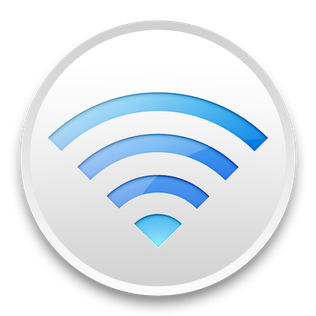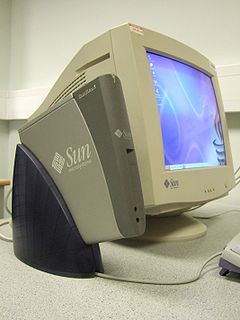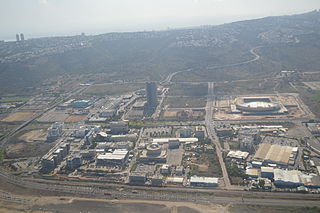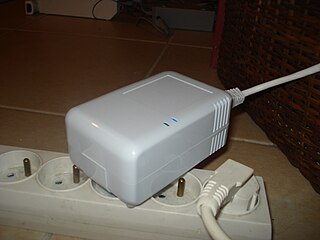
In computer networking, a thin client is a simple (low-performance) computer that has been optimized for establishing a remote connection with a server-based computing environment. The server does most of the work, which can include launching software programs, performing calculations, and storing data. This contrasts with a fat client or a conventional personal computer; the former is also intended for working in a client–server model but has significant local processing power, while the latter aims to perform its function mostly locally.

A desktop computer is a personal computer designed for regular use at a single location on or near a desk due to its size and power requirements. The most common configuration has a case that houses the power supply, motherboard, disk storage ; a keyboard and mouse for input; and a computer monitor, speakers, and, often, a printer for output. The case may be oriented horizontally or vertically and placed either underneath, beside, or on top of a desk.

AirPort is the name given to a series of products by Apple Inc. using the Wi-Fi protocols. These products comprise a number of wireless routers and wireless cards. The AirPort Extreme name was originally intended to signify the addition of the 802.11g protocol to these products.

In computing, a pizza box is a style of case for computers or network switches. Cases of this type tend to be wide and flat, normally 1 to 3 inches or 4 to 9 cm in height, thus resembling pizza delivery boxes.
Linux Terminal Server Project (LTSP) is a free and open source terminal server for Linux that allows many people to simultaneously use the same computer. Applications run on the server with a terminal known as a thin client handling input and output. Generally, terminals are low-powered, lack a hard disk and are quieter and more reliable than desktop computers because they do not have any moving parts.

The ThinkCentre is a line of business-oriented desktop computers designed, developed and marketed by Lenovo. It was initially sold by IBM from 2003 to 2005. ThinkCentre computers typically include mid-range to high-end processors, options for discrete graphics cards, and multi-monitor support.

The Sun Ray from Oracle is a stateless thin client solution aimed at corporate environments, originally introduced by Sun Microsystems in September 1999 and discontinued by Oracle in 2014. It featured a smart card reader and several models featured an integrated flat panel display.

A digital subscriber line (DSL) modem is a device used to connect a computer or router to a telephone line which provides the digital subscriber line service for connection to the Internet, which is often called DSL broadband. The modem connects to a single computer, through an Ethernet port, USB port, or is installed in a computer PCI slot.

Chip PC Technologies is a developer and manufacturer of thin client solutions and management software for server-based computing; where in a network architecture applications are deployed, managed and can be fully executed on the server.
The Sinomanic Tianhua GX-1C is a specially tailored subnotebook for primary and secondary school students in the People's Republic of China. It uses the Loongson I (Longxin) CPU. The device is designed for use as an educational aid and to introduce young students to computers.
The Linutop is a small, light, environmentally friendly Nettop computer containing a metal case and no moving parts, that runs the Linutop OS . Linutop Kiosk software and Linutop Tv server offer a full Digital signage solution. A variety of QT applications oriented towards secure web browsing and digital signage are available in the Operating system. Linutop is multimedia-capable and offers line-out/mic-in for sound. The device can be configured easily into a LTSP thin client. Linutop is suited for use in internet cafés, public libraries and schools.
The QCDOC is a supercomputer technology focusing on using relatively cheap low power processing elements to produce a massively parallel machine. The machine is custom-made to solve small but extremely demanding problems in the fields of quantum physics.
Userful Corporation is a Canadian software company that specializes in video walls, digital signage, interactive displays and desktop virtualization. Founded in 2003, Userful develops software that turns a standard PC into a high end video wall controller or video wall processor. Userful's head office is located in Calgary, Alberta and is a privately held for-profit company with resellers around the world.

DisplayLink is a semiconductor and software technology company. They develop the DisplayLink USB graphics technology, which is designed to connect computers and displays using USB, Ethernet, and WiFi. It also allows multiple displays to be connected to a single computer. DisplayLink's primary customers are notebook OEMs, LCD monitor manufacturers and PC accessory vendors, supporting the Microsoft Windows, macOS, Android, ChromeOS and Linux operating systems.

A nettop is a small-sized, inexpensive, low-power, legacy-free desktop computer designed for basic tasks such as web browsing, accessing web-based applications, document processing, and audio/video playback. The word nettop is a portmanteau of network and desktop. It is the desktop counterpart of the netbook. Modern mini PCs or small form factor PCs can be much more powerful, being equipped with high-end laptop components or mid-range desktop components.

A plug computer is an external device, often configured for use in the home or office as a compact computer. The name is derived from the small configuration of such devices; they are often enclosed in an AC power plug or AC adapter.
IT energy management or Green IT as per International Federation of Global & Green ICT "IFGICT" is the analysis and management of energy demand within the Information Technology department in any organization. IT energy demand accounts for approximately 2% of global CO
2 emissions, approximately the same level as aviation, and represents over 10% of all the global energy consumption. IT can account for 25% of a modern office building’s energy cost.

Wyse is an American manufacturer of cloud computing systems. They are best known for their video terminal line introduced in the 1980s, which competed with the market-leading Digital. They also had a successful line of IBM PC compatible workstations in the mid-to-late 1980s, but were outcompeted by companies such as Dell starting late in the decade. Current products include thin client hardware and software as well as desktop virtualization solutions. Other products include cloud software-supporting desktop computers, laptops, and mobile devices. Dell Cloud Client Computing is partnered with IT vendors such as Citrix, IBM, Microsoft, and VMware.

Computers can be classified, or typed, in many ways. Some common classifications of computers are given below.
ExpEther is a System Hardware Virtualization Technology that expands standard PCI Express beyond 1 km having thousands of roots and endpoint devices together on a single network connected through the standard Ethernet. Abundant commodities of PCI Express-based software and hardware can be utilized without any modification. It also provides software-defined re-configurability to make a disaggregated computing system with device-level.













